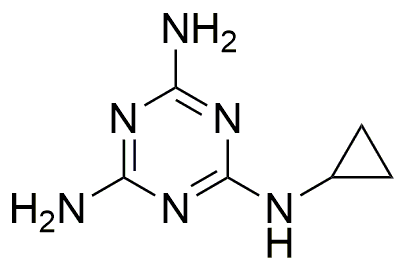Cyromazine is widely utilized in research focused on:
- Agricultural Pest Control: This compound is primarily used as an insect growth regulator in agriculture, effectively controlling pests like flies and mosquitoes without harming beneficial insects.
- Animal Health: In veterinary medicine, cyromazine is employed to manage insect populations in livestock, ensuring healthier animals and reducing the spread of disease.
- Public Health: It plays a crucial role in vector control programs, helping to reduce the incidence of insect-borne diseases in urban and rural settings.
- Research Applications: Scientists utilize cyromazine in studies related to insect physiology and behavior, providing insights that can lead to more effective pest management strategies.
- Environmental Safety: Compared to other insecticides, cyromazine has a lower toxicity profile, making it a safer choice for integrated pest management practices that prioritize environmental health.
General Information
Properties
Safety and Regulations
Applications
Cyromazine is widely utilized in research focused on:
- Agricultural Pest Control: This compound is primarily used as an insect growth regulator in agriculture, effectively controlling pests like flies and mosquitoes without harming beneficial insects.
- Animal Health: In veterinary medicine, cyromazine is employed to manage insect populations in livestock, ensuring healthier animals and reducing the spread of disease.
- Public Health: It plays a crucial role in vector control programs, helping to reduce the incidence of insect-borne diseases in urban and rural settings.
- Research Applications: Scientists utilize cyromazine in studies related to insect physiology and behavior, providing insights that can lead to more effective pest management strategies.
- Environmental Safety: Compared to other insecticides, cyromazine has a lower toxicity profile, making it a safer choice for integrated pest management practices that prioritize environmental health.
Documents
Safety Data Sheets (SDS)
The SDS provides comprehensive safety information on handling, storage, and disposal of the product.
Product Specification (PS)
The PS provides a comprehensive breakdown of the product’s properties, including chemical composition, physical state, purity, and storage requirements. It also details acceptable quality ranges and the product's intended applications.
Certificates of Analysis (COA)
Search for Certificates of Analysis (COA) by entering the products Lot Number. Lot and Batch Numbers can be found on a product’s label following the words ‘Lot’ or ‘Batch’.
*Catalog Number
*Lot Number
Certificates Of Origin (COO)
This COO confirms the country where the product was manufactured, and also details the materials and components used in it and whether it is derived from natural, synthetic, or other specific sources. This certificate may be required for customs, trade, and regulatory compliance.
*Catalog Number
*Lot Number
Safety Data Sheets (SDS)
The SDS provides comprehensive safety information on handling, storage, and disposal of the product.
DownloadProduct Specification (PS)
The PS provides a comprehensive breakdown of the product’s properties, including chemical composition, physical state, purity, and storage requirements. It also details acceptable quality ranges and the product's intended applications.
DownloadCertificates of Analysis (COA)
Search for Certificates of Analysis (COA) by entering the products Lot Number. Lot and Batch Numbers can be found on a product’s label following the words ‘Lot’ or ‘Batch’.
*Catalog Number
*Lot Number
Certificates Of Origin (COO)
This COO confirms the country where the product was manufactured, and also details the materials and components used in it and whether it is derived from natural, synthetic, or other specific sources. This certificate may be required for customs, trade, and regulatory compliance.


